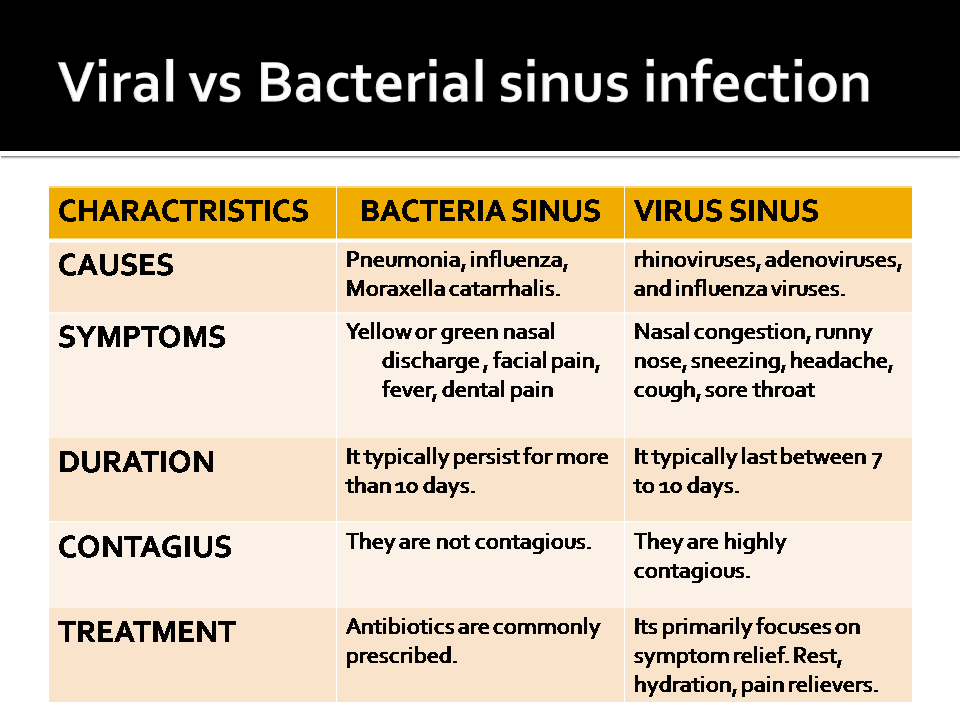Here you will learn about “Viral vs Bacterial sinus infection”.

Sinus infections, also known as sinusitis, can be quite uncomfortable. It often results from various causes, with viral and bacterial infections being the most common culprits.
Understanding the difference between these two types of sinus infections is crucial for proper diagnosis and treatment. Let’s explore the characteristics, causes, symptoms, and treatment options for viral and bacterial sinus infections.
Viral Sinus Infections
Viral sinus infections are more prevalent than their bacterial counterparts. They typically occur as a result of the common cold or other viral infections, such as the flu. Here are some characteristics of viral sinus infections:
- Cause: Viral sinus infections are caused by viruses, most commonly rhinoviruses, adenoviruses, and influenza viruses.
- Symptoms: Symptoms of viral sinus infections often overlap with those of bacterial sinus infections. They may include nasal congestion, runny nose, sneezing, headache, cough, and a sore throat. However, viral infections are more likely to produce clear or watery nasal discharge.
- Duration: Viral sinus infections are usually shorter in duration, typically lasting between 7 to 10 days.
- Contagious: These infections are highly contagious and can easily spread from person to person through respiratory droplets.
- Treatment: Treatment for viral sinus infections primarily focuses on symptom relief. Rest, hydration, over-the-counter (OTC) decongestants, and pain relievers can help manage symptoms. Antibiotics are not effective against viruses, so they are not typically prescribed for viral sinusitis.
Bacterial Sinus Infections
Bacterial sinus infections are less common than viral ones, but they can be more severe and persistent. These infections occur when bacteria invade the sinus cavities. Here are some key characteristics of bacterial sinus infections:
- Cause: Bacterial sinus infections are primarily caused by bacteria, most commonly Streptococcus pneumoniae, Haemophilus influenzae, and Moraxella catarrhalis.
- Symptoms: Symptoms of bacterial sinus infections are similar to those of viral infections but tend to be more severe. They include thick yellow or green nasal discharge, facial pain or pressure, fever, fatigue, and dental pain.
- Duration: Bacterial sinus infections often last longer than viral ones, typically persisting for more than 10 days, and can sometimes become chronic, lasting for weeks or even months.
- Contagious: While bacterial sinus infections themselves are not contagious, the underlying viral infections that can lead to them are.
- Treatment: Antibiotics are commonly prescribed to treat bacterial sinus infections. The choice of antibiotic depends on the specific bacteria causing the infection. Patients are typically advised to complete the full course of antibiotics, even if symptoms improve before the medication is finished. Symptomatic relief through OTC medications like decongestants and pain relievers may also be recommended.
Distinguishing Between Viral and Bacterial Sinus Infections
It can be challenging to distinguish between viral and bacterial sinus infections based solely on symptoms because they share many common features. However, there are certain criteria to help make an accurate diagnosis between them:
- Duration of Symptoms: Viral sinus infections typically resolve within 7 to 10 days, while bacterial infections tend to last longer.
- Nature of Nasal Discharge: Viral infections often produce clear or watery nasal discharge, while bacterial infections may result in thick yellow or green discharge.
- Fever: The presence of a fever is more common in bacterial sinus infections.
- Facial Pain: Severe facial pain or pressure may suggest a bacterial infection.
1 thought on “Viral vs Bacterial sinus infection”